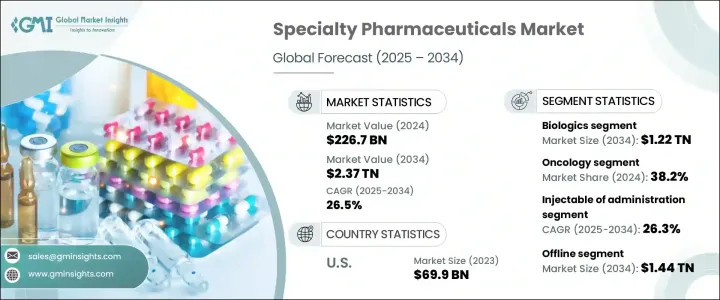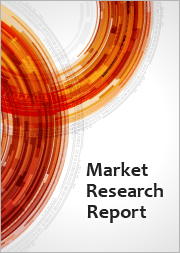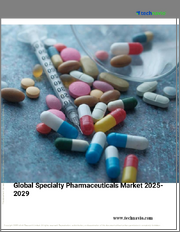
|
시장보고서
상품코드
1740798
세계의 특수 의약품 시장 : 기회와 촉진요인, 업계 동향 분석, 예측(2025-2034년)Specialty Pharmaceuticals Market Opportunity, Growth Drivers, Industry Trend Analysis, and Forecast 2025 - 2034 |
||||||
세계의 특수 의약품 시장은 2024년 2,267억 달러였고, 생물 제제, 표적 치료, 정밀의료에 있어서의 획기적인 진보에 의해 CAGR 26.5%로 성장하여 2034년에는 2조 3,700억 달러에 달할 것으로 예측되고 있습니다.
특수 의약품은 이전에 제한된 선택이었던 만성 및 희귀질환에 대해 고도로 맞춤화된 치료를 제공함으로써 건강 관리를 빠르게 변화시키고 있습니다. 암, 자가 면역 질환, 희귀 유전성 질환 등의 만성 질환 증가는 이러한 고도의 치료에 대한 수요를 점점 강화하고 있습니다. 생명공학이 발전함에 따라, 새로운 약물 전달 시스템과 정밀 진단이 치료 프로토콜을 재구성하고, 더 적은 부작용으로 더 나은 치료 결과를 환자에게 가져오게 되었습니다.

개인화 건강 관리에 대한 관심은 가속화되고 있으며, 제약 회사는 유전자 기반 솔루션, 생물학적 제제 및 환자 고유의 요구에 맞는 맞춤형 치료에 많은 투자를 실시했습니다. 헬스케어 인프라의 확대로 특 수요법이 신흥국 시장에 진출할 새로운 기회가 탄생하고 있습니다.
| 시장 범위 | |
|---|---|
| 시작 연도 | 2024년 |
| 예측 연도 | 2025-2034년 |
| 시작 금액 | 2,267억 달러 |
| 예측 금액 | 2조 3,700억 달러 |
| CAGR | 26.5% |
의약품 유형별로는 생물제제, 바이오시밀러, 희소질병용 의약품, 저분자 의약품 및 기타 특수 제제가 있습니다. 자가면역질환, 각종 암, 희소유전성 질환 등의 복잡한 병태에 대해서 고도로 타겟을 좁힌 치료를 가능하게 합니다. 부작용이 적고 성공률이 높은 생물 제제는 세계의 임상 현장에서 급속히 채용되고 있습니다.
치료 영역별로는 암 영역이 2024년에 38.2% 시장 점유율을 획득해 계속 우위를 차지하고 있으며, 2034년까지의 CAGR은 26.7%로 성장할 전망입니다. 모방적인 투자를 촉진하고 새로운 치료법의 승인이 꾸준히 진행되고 있습니다.
미국 특수 의약품 2023년 시장 규모는 699억 달러로 미국의 리더십과 혁신 주도의 헬스케어 환경을 반영하고 있습니다. 맞춤형 의료에 대한 수요의 높이, FDA의 승인 경로의 신속화, 획기적인 혁신에의 주력이, 시장의 지속적인 성장을 확실히 하고 있습니다.
세계의 특수 의약품 시장에서 사업을 전개하고 있는 주요 기업으로는 United Therapeutics, Amgen, AbbVie, Novartis, Pfizer, Genentech, Kamada, Biocon Biologics, TAIHO PHARMACEUTICAL, Eli Lilly, Knight Therapeutics, Incyte, Merck &Co., GlaxoSmithKline 등이 있습니다. 이러한 기업은 목표를 좁힌 연구개발에 대한 투자, 전략적 파트너십 형성, 혁신적인 생명공학 기업 인수, 장기적인 성장을 가속하기 위한 바이오시밀러와 맞춤형 치료의 중시 등에 의해 그 지위를 강화하고 있습니다.
목차
제1장 조사 방법과 범위
제2장 주요 요약
제3장 업계 인사이트
- 생태계 분석
- 업계에 미치는 영향요인
- 성장 촉진요인
- 만성질환 및 희소질환의 유병률 상승
- 생물제제와 유전자 치료의 진보
- 희소질환용 의약품에 대한 지원 정책과 독점권 확대
- 연구개발 자금과 활동 증가
- 업계의 잠재적 위험 및 과제
- 약가의 상승
- 전문적인 보관 및 취급의 필요성
- 성장 촉진요인
- 성장 가능성 분석
- 파이프라인 분석
- 규제 상황
- 트럼프 정권에 의한 관세에 대한 영향
- 무역에 미치는 영향
- 무역량의 혼란
- 보복 조치
- 업계에 미치는 영향
- 공급측의 영향(원재료)
- 주요 원재료의 가격 변동
- 공급망 재구성
- 생산 비용에 미치는 영향
- 수요측의 영향(판매가격)
- 최종 시장에의 가격 전달
- 시장 점유율 동향
- 소비자의 반응 패턴
- 공급측의 영향(원재료)
- 영향을 받는 주요 기업
- 전략적인 업계 대응
- 공급망 재구성
- 가격 설정 및 제품 전략
- 정책관여
- 전망과 향후 검토 사항
- 무역에 미치는 영향
- Porter's Five Forces 분석
- PESTEL 분석
제4장 경쟁 구도
- 소개
- 기업 매트릭스 분석
- 기업의 시장 점유율 분석
- 주요 시장 기업의 경쟁 분석
- 경쟁 포지셔닝 매트릭스
- 전략 대시보드
제5장 시장 추계 및 예측 : 약제유형별, 2021-2034년
- 주요 동향
- 생물학적 제형
- 바이오시밀러
- 희귀질환용 의약품
- 저분자
- 기타 약물의 유형
제6장 시장 추계 및 예측 : 치료 영역별, 2021-2034년
- 주요 동향
- 종양학
- 자가면역질환
- 신경학
- 감염증
- 드문 유전성 질환
- 기타 치료 영역
제7장 시장 추계 및 예측 : 투여 경로별, 2021-2034년
- 주요 동향
- 경구
- 주사제
- 기타 투여 경로
제8장 시장 추계 및 예측 : 유통채널별, 2021-2034년
- 주요 동향
- 온라인
- 오프라인
- 병원 약국
- 소매 약국
- 기타 오프라인 채널
제9장 시장 추계 및 예측 : 지역별, 2021-2034년
- 주요 동향
- 북미
- 미국
- 캐나다
- 유럽
- 독일
- 영국
- 프랑스
- 스페인
- 이탈리아
- 네덜란드
- 아시아태평양
- 중국
- 인도
- 일본
- 호주
- 한국
- 라틴아메리카
- 브라질
- 멕시코
- 아르헨티나
- 중동 및 아프리카
- 남아프리카
- 사우디아라비아
- 아랍에미리트(UAE)
제10장 기업 프로파일
- AbbVie
- Amgen
- Biocon Biologics
- Eli Lilly
- Genentech
- GlaxoSmithKline
- Incyte
- Kamada
- Knight Therapeutics
- Merck & Co.
- Novartis
- Pfizer
- Taiho Pharmaceutical
- United Therapeutics
The Global Specialty Pharmaceuticals Market was valued at USD 226.7 billion in 2024 and is estimated to grow at a CAGR of 26.5% to reach USD 2.37 trillion by 2034, driven by groundbreaking advancements in biologics, targeted therapies, and precision medicine. Specialty pharmaceuticals are quickly transforming healthcare by offering highly tailored treatments for chronic and rare diseases that previously had limited options. The rise in chronic conditions like cancer, autoimmune disorders, and rare genetic illnesses continues to intensify the demand for these sophisticated therapies. As biotechnology advances, new drug delivery systems and precise diagnostics are reshaping treatment protocols, delivering better patient outcomes with fewer side effects.

The focus on personalized healthcare is accelerating, with pharmaceutical companies investing heavily in gene-based solutions, biologics, and customized therapies that align with patient-specific needs. Governments worldwide are supporting innovation through incentives and streamlined regulatory pathways, particularly for orphan drugs targeting rare diseases. In developing regions, expanding healthcare infrastructure is opening new opportunities for specialty therapies to enter emerging markets. As healthcare systems evolve, specialty pharmaceuticals are no longer confined to niche segments; they are becoming an integral part of mainstream treatment strategies, establishing themselves as a crucial growth engine within the pharmaceutical landscape.
| Market Scope | |
|---|---|
| Start Year | 2024 |
| Forecast Year | 2025-2034 |
| Start Value | $226.7 Billion |
| Forecast Value | $2.37 Trillion |
| CAGR | 26.5% |
The market by drug type spans biologics, biosimilars, orphan drugs, small molecules, and other specialty formulations. In 2024, the biologics segment generated USD 118.8 billion, with projections indicating a strong surge to USD 1.22 trillion by 2034. This remarkable growth stems from the therapeutic precision biologics offer, enabling highly targeted treatments for complex conditions like autoimmune diseases, various cancers, and rare genetic disorders. With fewer side effects and higher success rates, biologics have gained rapid adoption in clinical practices worldwide. Advances in biological manufacturing technologies and supportive regulatory frameworks are helping companies accelerate the development and launch of innovative biologic therapies.
By therapeutic area, oncology continues to dominate, capturing a 38.2% market share in 2024, and is poised to grow at a CAGR of 26.7% through 2034. Rising global cancer incidence rates are fueling massive investments in oncology drug pipelines, with a steady flow of regulatory approvals for new therapies. Breakthroughs in immunotherapies, companion diagnostics, and combination therapies are reshaping the future of cancer care and reinforcing oncology's leadership in the specialty pharmaceutical sector.
The U.S. Specialty Pharmaceuticals Market generated USD 69.9 billion in 2023, reflecting its leadership and innovation-driven healthcare environment. Strong funding support, favorable reimbursement systems, and public-private collaborations position the U.S. at the forefront of specialty drug development. High demand for personalized medicine, accelerated FDA approval pathways, and a focus on breakthrough innovations ensure the market's sustained growth trajectory.
Key companies operating in the Global Specialty Pharmaceuticals Market include United Therapeutics, Amgen, AbbVie, Novartis, Pfizer, Genentech, Kamada, Biocon Biologics, TAIHO PHARMACEUTICAL, Eli Lilly, Knight Therapeutics, Incyte, Merck & Co., and GlaxoSmithKline. These players are strengthening their positions by investing in targeted R&D, forming strategic partnerships, acquiring innovative biotech firms, and emphasizing biosimilars and personalized therapies to drive long-term growth.
Table of Contents
Chapter 1 Methodology and Scope
- 1.1 Market scope and definition
- 1.2 Research design
- 1.2.1 Research approach
- 1.2.2 Data collection methods
- 1.3 Base estimates and calculations
- 1.3.1 Base year calculation
- 1.3.2 Key trends for market estimation
- 1.4 Forecast model
- 1.5 Primary research and validation
- 1.5.1 Primary sources
- 1.5.2 Data mining sources
Chapter 2 Executive Summary
- 2.1 Industry 360° synopsis
Chapter 3 Industry Insights
- 3.1 Industry ecosystem analysis
- 3.2 Industry impact forces
- 3.2.1 Growth drivers
- 3.2.1.1 Rising prevalence of chronic and rare diseases
- 3.2.1.2 Increasing advancements in biologics and gene therapies
- 3.2.1.3 Increasing supportive policies and exclusivity rights for orphan drugs
- 3.2.1.4 Growing in research and development fundings and activities
- 3.2.2 Industry pitfalls and challenges
- 3.2.2.1 Hight cost of drugs
- 3.2.2.2 Necessity of specialized storge and handling
- 3.2.1 Growth drivers
- 3.3 Growth potential analysis
- 3.4 Pipeline analysis
- 3.5 Regulatory landscape
- 3.6 Trump administration tariffs
- 3.6.1 Impact on trade
- 3.6.1.1 Trade volume disruptions
- 3.6.1.2 Retaliatory measures
- 3.6.2 Impact on the Industry
- 3.6.2.1 Supply-side impact (raw materials)
- 3.6.2.1.1 Price volatility in key materials
- 3.6.2.1.2 Supply chain restructuring
- 3.6.2.1.3 Production cost implications
- 3.6.2.2 Demand-side impact (selling price)
- 3.6.2.2.1 Price transmission to end markets
- 3.6.2.2.2 Market share dynamics
- 3.6.2.2.3 Consumer response patterns
- 3.6.2.1 Supply-side impact (raw materials)
- 3.6.3 Key companies impacted
- 3.6.4 Strategic industry responses
- 3.6.4.1 Supply chain reconfiguration
- 3.6.4.2 Pricing and product strategies
- 3.6.4.3 Policy engagement
- 3.6.5 Outlook and future considerations
- 3.6.1 Impact on trade
- 3.7 Porter's analysis
- 3.8 PESTEL analysis
Chapter 4 Competitive Landscape, 2024
- 4.1 Introduction
- 4.2 Company matrix analysis
- 4.3 Company market share analysis
- 4.4 Competitive analysis of major market players
- 4.5 Competitive positioning matrix
- 4.6 Strategy dashboard
Chapter 5 Market Estimates and Forecast, By Drug Type, 2021 – 2034 ($ Mn)
- 5.1 Key trends
- 5.2 Biologics
- 5.3 Biosimilars
- 5.4 Orphan drugs
- 5.5 Small molecules
- 5.6 Other drug types
Chapter 6 Market Estimates and Forecast, By Therapeutic Area, 2021 – 2034 ($ Mn)
- 6.1 Key trends
- 6.2 Oncology
- 6.3 Autoimmune diseases
- 6.4 Neurology
- 6.5 Infectious diseases
- 6.6 Rare genetic disorders
- 6.7 Other therapeutic areas
Chapter 7 Market Estimates and Forecast, By Route of Administration, 2021 – 2034 ($ Mn)
- 7.1 Key trends
- 7.2 Oral
- 7.3 Injectables
- 7.4 Other routes of administration
Chapter 8 Market Estimates and Forecast, By Distribution Channel, 2021 – 2034 ($ Mn)
- 8.1 Key trends
- 8.2 Online
- 8.3 Offline
- 8.3.1 Hospital pharmacies
- 8.3.2 Retail pharmacies
- 8.3.3 Other offline channels
Chapter 9 Market Estimates and Forecast, By Region, 2021 – 2034 ($ Mn)
- 9.1 Key trends
- 9.2 North America
- 9.2.1 U.S.
- 9.2.2 Canada
- 9.3 Europe
- 9.3.1 Germany
- 9.3.2 UK
- 9.3.3 France
- 9.3.4 Spain
- 9.3.5 Italy
- 9.3.6 Netherlands
- 9.4 Asia Pacific
- 9.4.1 China
- 9.4.2 India
- 9.4.3 Japan
- 9.4.4 Australia
- 9.4.5 South Korea
- 9.5 Latin America
- 9.5.1 Brazil
- 9.5.2 Mexico
- 9.5.3 Argentina
- 9.6 Middle East and Africa
- 9.6.1 South Africa
- 9.6.2 Saudi Arabia
- 9.6.3 UAE
Chapter 10 Company Profiles
- 10.1 AbbVie
- 10.2 Amgen
- 10.3 Biocon Biologics
- 10.4 Eli Lilly
- 10.5 Genentech
- 10.6 GlaxoSmithKline
- 10.7 Incyte
- 10.8 Kamada
- 10.9 Knight Therapeutics
- 10.10 Merck & Co.
- 10.11 Novartis
- 10.12 Pfizer
- 10.13 Taiho Pharmaceutical
- 10.14 United Therapeutics















